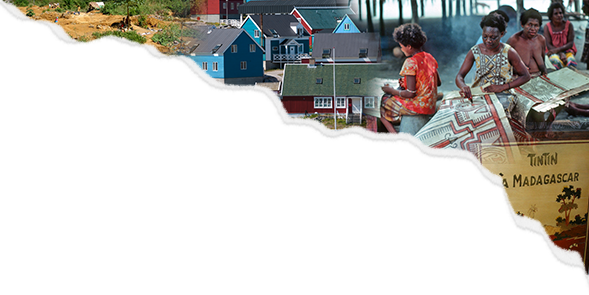By Andrew Gilbert
In Part I of this essay, I discussed the design and goals of a new course I had developed on graphic novels in an upper-year anthropology seminar course. In Part II, I consider some of the broader take-away lessons for teaching with sequential art.
I decided to begin the course with the childhood memoirs (Persepolis, Marzi, Fatherland), and one thing we learned is that—like childhood more generally—they provide a good lens through which to view the cultural and social norms of a time and place. By putting a lens on socialization, on the child’s experience of the world as strange and contradictory and fantastical, and as deeply felt, readers are offered the kind of insight that parallels the experience anthropologists have in learning about another culture. This effect was heightened by those books that kept non-English words and scripts in the narrative or as part of the visual landscape.
Also, students noted that as readers, while they may not have grown up in Iran, or Poland, or Yugoslavia, they had their own socialization experiences, and this created points of connection and comparative reflection. It was also during our reading of the memoirs that students were introduced to the more-than-realist possibilities of the graphic genre, and how this aided in communicating the emotional or affective dimensions of socialization. These include rage about the inequalities of class difference, gender discrimination, or political injustice, as well as the suffering of loss, and the joy of accomplishment. Finally, students remarked that representing events of revolution, dissent, and political terrorism through the eyes of children and their kinship relations was a potent way of grounding the meaning and stakes of those events. If the meaning of a thing, event, or statement lies in in part in how it feels, graphic novels seem to have a unique capacity to affect the emotions of readers. Indeed, depicting a full range of emotions played an important part in humanizing marginalized populations for students, like the refugees and migrants they encountered while reading Threads from the Refugee Crisis.
Another way that anthropologists learn about societies different from their own is by bumbling around and making mistakes. Indeed, one of the quickest ways to learn a social or cultural norm is to violate it, and ethnographies are replete with such stories. At least two of the graphic novels we read contained such para-ethnographic encounters, in this case of journalists (Joe Sacco and Sarah Glidden) working outside of their home countries. Although the authors were central characters in all of the books on our reading list except one, the books by Sacco and Glidden introduced readers to the kinds of uncertainty that accompanies trying to learn something in unfamiliar historical, cultural, and social contexts. Moreover, the visual medium meant that readers never forgot the role of the author, the kinds of social settings from which knowledge is generated, or that it is co-produced between the author and the people they learn from.
We spent considerable time analyzing the various elements that made up the graphic novels (color, shading, panel size, location, etc.) and discussing what kinds of effects they had on us as readers. This goal of the course—a deep exploration between what we know and how we come to know it—was also aided by comparing the graphic novels to other media. For example, Sarah Glidden’s book depicted the production of news media, some of which could be viewed separately, including the news articles and a documentary film produced by the journalists she was observing, as well as a video blog made by an ex-Marine who was along for the journey. The events covered in March can be found in photographs, filmed reminiscences, newspaper articles and reports from the time and era, and even songs sung by the Freedom Riders. Persepolis was made into an animated film. And there are any number of documentary films or television reports about the Arab Spring in Cairo, and about the state of health care in Egypt – the main subjects of the book Lissa. Reflecting on what effect sound, moving pictures, or still photographs had on us compared to the same events, or relationships, or people found in the graphic novels allowed us to get more specific about the unique affordances of each media form.
It is worth mentioning that some students were initially attracted to the course because I had previously used Lissa in an introductory course on cultural anthropology, and they were intrigued and excited by the possibilities of a whole course that only used graphic novels. My impression was that students initially thought that reading graphic novels was easier than reading more traditional ethnographies, but by the end of the course that initial thought had matured into an appreciation that it was not necessarily easier, just different. That said, students observed that the reading experience was not as laborious as with other courses’ texts, and most did not feel that reading one graphic novel per week was a burden. That meant I could assign and accomplish more than I might have been able to with more traditional texts. Also, as I stated in Part I of this post, we approached these books by thinking about their affordances, recognizing that the affordances of any particular example of sequential art lay not only in the properties of the art itself, but also in the person perceiving it. This not only provoked students to reflect on how and why they interpreted the meaning of the books in the way that they did, but in doing so it seemed to make them more comfortable with sharing their perspectives. Put differently,
one advantage of teaching with graphic novels may be that the form seems more approachable and less intimidating to students and thus invites them to participate in discussion in ways not possible with more traditional “academic” texts.
One final observation: This course was taught in Canada over a twelve-week semester. Many of the pedagogical effects that I have described here had been accomplished by about week nine. After that, the discussions felt repetitive. In a future course of similar length, I would probably redesign this as a visual anthropology course (and make sequential art one of multiple media we consider), or complement the discussion about the affordances of sequential art in research communication with a discussion of the affordances of graphic methods in research practice. Here too there is a growing catalogue of material on how to encourage students and other researchers to take advantage of drawing as research method (Bonnano 2019, Causey 2017, Taussig 2011).
Andrew Gilbert is a Senior Researcher at the Ethnography Lab at the University of Toronto and a sociocultural anthropologist who has been conducting ethnographic research in Bosnia and Herzegovina for nearly twenty years. His first research project focused on the politics of international intervention and the relationship between the historical imagination (how people conceive of history) and the political imagination (how people conceive what is politically possible). Recent research has investigated the conditions that create openings and closures to political experimentation and social transformation, focusing on a series of worker-initiated protests and their aftermath in the Bosnian city of Tuzla. This has led to a growing interest in collaboration and in the political and ethnographic potential of diverse media, such as audio documentary, photographs, and graphic ethnography.



